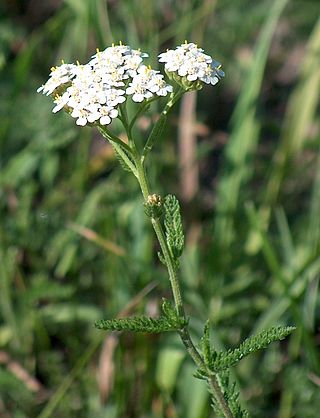
Achillea is a genus of flowering plants in the family Asteraceae, known colloquially as yarrows. The plants typically have frilly leaves. The common name "yarrow" usually refers to A. millefolium. The genus was named after the Greek mythological character Achilles, whose soldiers were said to have used yarrow to treat their wounds; this is reflected by common names such as allheal and bloodwort. The genus is native primarily to Eurasia and North America.
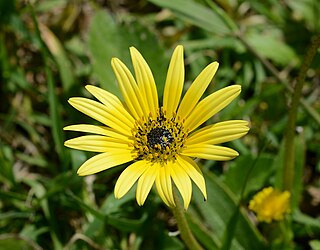
Arctotis is a genus of annual and perennial plants in the family Asteraceae.

Daphne is a genus of between 70 and 95 species of deciduous and evergreen shrubs in the family Thymelaeaceae, native to Asia, Europe and north Africa. They are noted for their scented flowers and often brightly coloured berries. Two species are used to make paper. Many species are grown in gardens as ornamental plants; the smaller species are often used in rock gardens. All parts of daphnes are poisonous, especially the berries.
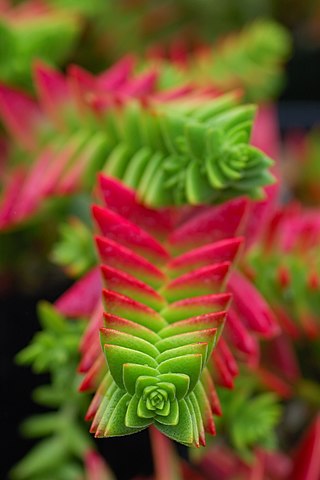
Crassula is a genus of succulent plants containing about 200 accepted species, including the popular jade plant. They are members of the stonecrop family (Crassulaceae) and are native to many parts of the globe, but cultivated varieties originate almost exclusively from species from the Eastern Cape of South Africa.
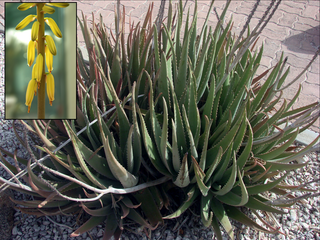
Aloe vera is a succulent plant species of the genus Aloe. It is widely distributed, and is considered an invasive species in many world regions.
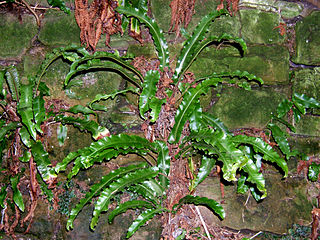
Asplenium scolopendrium, commonly known as the hart's-tongue fern, is an evergreen fern in the family Aspleniaceae native to the Northern Hemisphere.

Tiarella cordifolia, the heart-leaved foamflower, is a species of flowering plant in the family Saxifragaceae. The specific name cordifolia means "with heart-shaped leaves", a characteristic shared by all taxa of Tiarella in eastern North America. It is also referred to as Allegheny foamflower, false miterwort, and coolwort.

Tiarella, the foamflowers, is a genus of flowering plants in the family Saxifragaceae. The generic name Tiarella means "little turban", which suggests the shape of the seed capsules. Worldwide there are seven species, one each in eastern Asia and western North America, plus five species in eastern North America. As of October 2022, the taxonomy of Tiarella in eastern North America is in flux.

Erythronium dens-canis, the dog's-tooth-violet or dogtooth violet, is a bulbous herbaceous perennial flowering plant in the family Liliaceae, growing to 25 cm (10 in). It is native to central and southern Europe from Portugal to Ukraine. It is the only naturally occurring species of Erythronium in Europe. Despite its common name, it is not closely related to the true violets of genus Viola.

Yucca gloriosa is a species of flowering plant in the family Asparagaceae, native to the southeastern United States. Growing to 2.5 m (8 ft), it is an evergreen shrub. It is widely cultivated as an ornamental for its architectural qualities, and has reportedly become established in warmer climates in the wild in various parts of the world.

Symphyotrichum lateriflorum is a species of flowering plant in the aster family (Asteraceae). Commonly known as calico aster, starved aster, and white woodland aster, it is native to eastern and central North America. It is a perennial and herbaceous plant that may reach heights up to 120 centimeters and widths up to 30 centimeters.

Micranthes nivalis is a plant species in the saxifrage family. It is commonly called snow saxifrage or (ambiguously) alpine saxifrage.
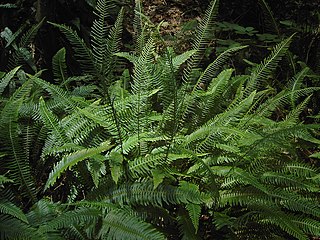
Struthiopteris spicant, syn. Blechnum spicant, is a species of fern in the family Blechnaceae, known by the common names hard-fern or deer fern. It is native to Europe, western Asia, northern Africa, and western North America. Like some other species in the family Blechnaceae, it has two types of leaves. The sterile leaves have flat, wavy-margined leaflets 5 to 8 millimeters wide, while the fertile leaves have much narrower leaflets, each with two thick rows of sori on the underside.

Crassula tetragona is a succulent plant native to Southern Africa. It is widely distributed from the Orange River boundary of Namaqualand to beyond the Kei River in the Eastern Cape. "Tetragona" comes from the phyllotaxy of the leaves. It is popularly named the "miniature pine tree" among ornamental plant enthusiasts, for its popular use as a "pine tree" in Bonsai.
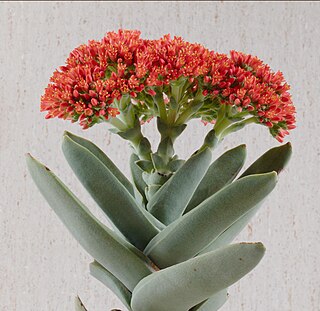
Crassula perfoliata var. falcata, known by the common names airplane plant and propeller plant, is a succulent plant endemic to South Africa, from the Cape of Good Hope. The foliage is gray-green with striking texture, on plants that grow to 2 feet (0.61 m) tall. The flowers are tiny and scarlet red, that rise in dense clusters above the foliage for a month in summer. Crassula falcata is cultivated for use in drought tolerant and succulent gardens, and in container gardens.
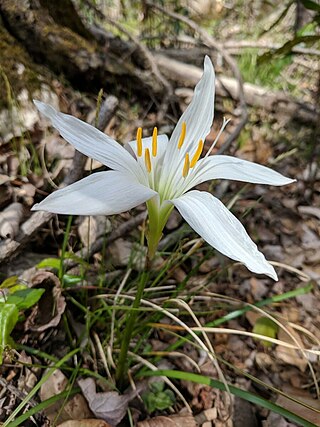
Zephyranthes atamasca, commonly known as the atamasco-lily or more generally a rain-lily, is native to the southeastern United States. It grows in swampy forests and coastal prairies, preferring acid boggy soils rich with leaf mold. Following the appearance of broad, grassy leaves in early winter, it blooms in March or April. It has several narrow, linear basal leaves about 0.5 in (13 mm) wide and 10–15 in (25–38 cm) long. Its native range extends from Florida north to Maryland and west to Mississippi. The species is also naturalized in Bermuda and in the Mariana Islands. Both its leaves and bulbs are poisonous.

Narcissus bulbocodium, the petticoat daffodil or hoop-petticoat daffodil, is a species of flowering plant in the family Amaryllidaceae, native to southern and western France, Portugal, and Spain. Some sources say that the species is also native to Morocco, but this is based on populations formerly thought to be varieties of N. bulbocodium but now regarded as separate species.
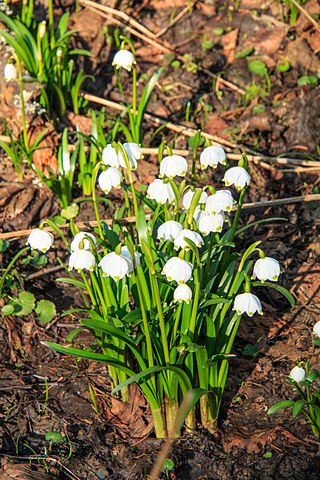
Leucojum vernum, called the spring snowflake, is a species of flowering plant in the family Amaryllidaceae. It is native to central and southern Europe from Belgium to Ukraine. It is considered naturalized in north-western Europe, including Great Britain and parts of Scandinavia, and in the US states of Georgia and Florida. This spring flowering bulbous herbaceous perennial is cultivated as an ornamental for a sunny position. The plant multiplies in favourable conditions to form clumps. Each plant bears a single white flower with greenish marks near the tip of the tepal, on a stem about 10–20 cm (3.9–7.9 in) tall, occasionally more.

Delphinium elatum is a species of flowering plant in the buttercup family Ranunculaceae, known by the common name alpine delphinium or candle larkspur. It is native to temperate Asia and Europe, it is an erect herbaceous perennial growing to 1.8 m (5.9 ft), with deeply divided leaves. It produces spikes of blue or purple flowers in summer.



















